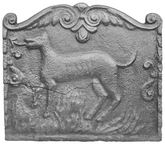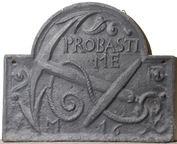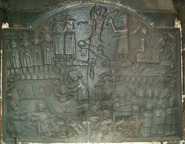-
851
Description: Rectangular with mirrored floriate scrolled top; simulated overlapping tile edging at sides, with fillet bottom edge; a mythical salamander in the form of a dog with an arrow-shaped tongue, standing among flames; a stapled scroll inside the left and right edges.
Notes: This fireback was used to create a composite fireback design on a plate at Rivers Farmhouse, Ardingly (no. 13).
- Decoration tags:
- rectangular (shape)
- simulated overlapping tile (edging)
- whole carved pattern
- mythological
- animals
- objects
Manufactured: in the mid-17th century in the Weald area of England.
Current location: not known.
Citation: Lloyd, N., 1925, 'Domestic Ironwork I', Architectural Review, 58, pp. 58-67.
- Attached to series:
- Stapled scroll series
- Brede group
-
408
Description: Arched rectangular shape; cavetto moulded edge all round; holes pierced in top corners; a fouled anchor with one fluke resting on the base, a scroll below each top corner, foliage above the text, which is above the anchor; the initials either side of the lower fluke.
Notes: The inscription is a quotation from Psalms 139, v. 1: ‘Domine, probasti me et cognovisti me’ (Lord, thou hast searched me and known me).
Copies of this fireback are known.
Inscription: PROBASTI / ME / I M 16 5[0?]
- Decoration tags:
- rectangular with round arch (shape)
- cavetto (edging)
- whole carved pattern
- individual numbers
- planklines
- pictorial
- biblical
- text
- objects
Manufactured: in the mid-17th century possibly at Brede Furnace in the Weald area of England.
Current location: Anne of Cleves House, Southover High Street, Lewes, East Sussex, England.
Museum number: LH000.908 (part of the Sussex Archaeological Society museum group)
Citation: Dawson, C., 1903, 'Sussex Iron Work and Pottery', Sussex Archaeological Collections, 46, pp. 1-54.
-
901
Description: Quasi-Arched rectangular shape with cyma reversa shoulders; ovolo edging; stylised lion passant guardant; crowned rose with leaf and stem on left, crowned fleur de lys on right, thistle with leaves above centre; three right-facing scrolls at base; down-facing scroll, with staple, on right side; date split between bottom corners; initials below date, bottom right.
Notes: Blatantly Royalist in its symbolism, a variant (no. 763) is dated (perhaps less convincingly) 1649. Numeral style, initials, leaf depiction and the stapled scroll are typical features of firebacks made from patterns by the same maker. A later version of the same subject, but with a different shaped plate and without the fleur-de-lys, is also known (see 'Royalist series'). M. A. Lower writes of this design of fireback being cast at Waldron Furnace in Sussex (Lower, 1849, p.219). Inferior copies of this fireback were advertised in Kings Worthy Foundry's (Winchester) catalogue in the mid-20th century.
Copies of this fireback are known.
Inscription: 16 41 / IM
- Decoration tags:
- rectangular with round arch (shape)
- ovolo (edging)
- whole carved pattern
- heraldic
- royal
- text
- animals
Manufactured: in 1641 possibly at Brede Furnace in the Weald area of England.
Current location: in private hands, Wandsworth, London, England.
- Attached to series:
- IM series
- Hooked '1' series
- Stapled scroll series
- Brede group
-
763
Description: Quasi-Arched rectangular shape with cyma reversa shoulders; ovolo edging; stylised lion passant guardant; crowned rose with leaf and stem on left, crowned fleur de lys on right, thistle with leaves above centre; three right-facing scrolls at base; down-facing scroll, with staple, on right side; date split between bottom corners; initials below date, bottom right.
Notes: Blatantly Royalist in its symbolism, a variant (no. 901) is dated (perhaps more convincingly) 1641. Numeral style, initials, leaf depiction and the stapled scroll are typical features of firebacks made from patterns by the same maker. A later version of the same subject, but with a different shaped plate and without the fleur-de-lys, is also known (see 'Royalist series'). M. A. Lower writes of firebacks of this design of being cast at Waldron Furnace in Sussex (Lower, 1849, p.219). Copies were advertised in F. Parkin & Sons (Exeter) catalogue in 1972.
Copies of this fireback are known.
Inscription: 16 49 / IM
- Decoration tags:
- rectangular with round arch (shape)
- ovolo (edging)
- whole carved pattern
- heraldic
- royal
- text
- animals
Manufactured: in 1649 possibly at Brede Furnace in the Weald area of England.
Current location: Victoria & Albert Museum, Cromwell Road, Kensington & Chelsea, Greater London, England.
Museum number: 492.1901 (part of the Victoria & Albert Museum museum group)
Citation: Lloyd, N., 1925, 'Domestic Ironwork I', Architectural Review, 58, pp. 58-67.
- Attached to series:
- IM series
- Hooked '1' series
- Stapled scroll series
- Brede group
-
94
Description: Arched rectangular shape; ovolo moulded edge all round; the fireback is divided, unequally, into three Old Testament scenes. Centre left: Joseph is pushed into a well shaft by one of his brothers; above, six other brothers, wearing cloaks and sober puritan hats, look on; below, one of Joseph’s brothers presents Jacob with Joseph’s coat; Joseph utters the words, ‘Ah it is my son’s coat’ in a speech bubble above. Top right: Isaac kneels on a wooden pyre; behind him, Abraham holds Isaac’s head with his left hand, and raises a cleaver above his head with his right hand; above Abraham, an angel stays his hand; to the right of Isaac a ram stands beside a bush. Bottom right: beneath a pergola Jacob lies on his deathbed; his twelve sons gather round his bed.
Notes: The scenes depicted are derived from, respectively, Genesis 38: 20-24 & 32-33, Genesis 22: 6-13, and Genesis 49. The distinctive pictorial subject, the naïve figuration, as well as a number of minor features, such as the use of an ‘S’ scroll, draw parallels with the Lenard fireback, and the pattern may have been the work of the same wood carver, suggesting that it may share the same source. Another, probably contemporary, example is at Hampton Court.
Copies of this fireback are known.
Inscription: AH IT IS MY SONES COT [Genesis 38: 33]
- Decoration tags:
- rectangular with round arch (shape)
- cavetto (edging)
- whole carved pattern
- pictorial
- biblical
- text
- humans
Manufactured: in the early- to mid-17th century possibly at Brede Furnace in the Weald area of England.
Current location: Squerryes Court, Westerham, Kent, England.




